Daily Dresses:
Cemedi Vesha: Every morning for MangalaArati Lord Jagannatha is dressed in a cotton sari. This is called His Cemedi Vesha.
Tadapa Vesha: For taking His morning bath, Lord Jagannatha is dressed in a 16’ long by 4’ wide orange and white cotton cloth. This is called Tadapa Vesha.
Utari Vesha: Utari means chadar, or wrapper. After His morning Darshana, Lord Jagannatha wears a 24’ long silk cloth as a chadar.
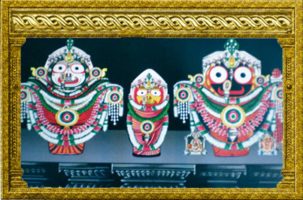
Bada Shringara Vesha: Every evening about 10:00 pm, before Jagannatha, Baladeva and Subhadra are put to rest, they are dressed in their Bada Shringara Vesha .Bada means great, and Shringara refer to the conjugal love of the Gopis and Radharani for Krishna. The Pandas consider that at this time every evening the Gopis and Radha comes to see Jagannatha. The Bada Shringara Vesha consists of Gita Govindam Khandua and eight floral ornaments.
The Gita Govindam Khandua is twelve foot long red silk cloths which are wrapped over each deity head. On these cloths are written lines from Jayadeva Goswami’s Gita Govindam. Gita Govindam is very dear to Jagannatha, so every evening it is recited His pleasure, and He is dressed with the Gita Govindam khandua. The eight floral ornaments are:
Candrika with alakapanti – An alaka or forehead decoration made entirely of flowers.
Puspatilaka – A flower garland tilaka sign on Jagannatha head.
Karapallaba – Made from fragrant dayanaleaf and varieties of flower, these are decoration representing the Lord’s hands five fingers.
Makara Kundala – Flower earrings shaped like sharks.
Padaka – Round or heart shaped, about 18 inches in diameter, this decoration covers Lord Jagannatha’s heart.
Guna and Jhumpa – Nose decorations made from flower.
Puspa Mala – Lord Jagannatha is dressed with many flower garlands each about twelve feet long, stretching from arm to arm.
Tulasi mala – Lord Jagannatha wear a crown of Tulasi garlands which are wrapped on pieces of bamboo and tied together.
As Noted in Panchratra Pradipa: “Many temples in Vrindavana dress the deity in the color corresponding to the day of the week.” The same basic system is followed in JagannathaPuri for the different colors of cloth used for the Bada Shringara Vesha. They are as follows:
Sunday – Ruled by the sun. Lord Jagannatha is generally dressed in red garments on this day the color of the ruby.
Monday – Ruled by the moon. Jagannatha wears white on this day, the color of pearl.
Tuesday – Ruled by the planet Mars. Jagannatha wears red or pink garments on this day, the color of the coral.
Wednesday – Ruled by Mercury. Lord Jagannatha wears green, the color of the emerald.
Thursday – Ruled by Jupiter. Jagannatha wear yellow or gold dress, the color of the yellow sapphire.
Friday – Ruled by the planet Venus. Lord Jagannatha wears white garments this day, the color of the diamond.
Saturday – Ruled by the planet Saturn. Jagannatha wear the black cloth on this day, corresponding to the color of the blue sapphire.
Makhamala Vesha: After the Bada Shringara Vesha, Lord Jagannatha is dressed in a special white cloth for sayanalila, his pastime of taking rest. This is called Makhamala Vesha.
Special Dresses:
In addition to different Daily Dresses offered to Lord Jagannatha, His servant offers Him special dresses at different special time of the year. A partial list follows:
Month of Vaishakha (April – May)
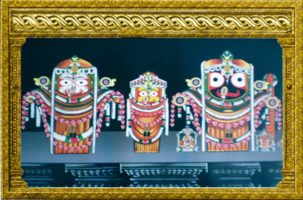
Chandan Vesha: Chandan Vesha is done for 42 days, every third bright day of the month Vaishakha (April-May) starting from “Akshayatritiya” day. Faring, sandal paste oil on the body of deity and decoration of flowers (Chula, Alaka, and Topar) is known as CHANDAN VESHA. First 21 days from “Akshaya tritiya are known as “outer Chandan yatra” and second 21 days are known as “inner chandan yatra”. In first 21 days begining from Akshaya tritiya,the Lord Madanmohan, representative of Lord Jagannath along with Sreedevi (Laxmi) and Bhudevi (Saraswati) ascending on Biman, Ram and Krishnairhsna in a palki along with local Sivas (Jameswar, Loknath, Kapal mochan, Markandeswar and Nilkanth) goes in procession to Narendra Tank for bath and boat journey.
Month of Jyestha (May – June)
Rukmini Harana Vesha: The tenth canto of Srimad Bhagavatam describes how Krishna kidnapped Rukmini and accepted her as His wife. At that time He came dressed as a powerful king. To commemorate this Pastime, on the Sukla Ekadasi of the month of Jyestha, Sri Madan Mohan dresses as an opulent ruler.
Hati Vesha:
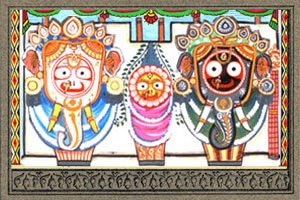
Hati means “elephant.” The full moon day of the month of Jyestha is the occasion of Lord Jagannatha’s Snana Yatra, when the Jagannatha, Baladeva and Subhadra Deities are bathed. Snana means “bathing.” This is done on Jyestha Purnima. The main Deities along with Sudarshana disc are bought to the snana mandapa (a platform in front of the temple). Around mid-day 108 pots of water are poured on the Deities from a sacred well which is dear to the goddess Sitala. An emissary of the king of Orissa ceremonially sweeps the platform. Then elephant-head masks are put on the Deities. This is their Hati Vesha (Elephant dress). The Deities are then offered cooked food and an arati is performed. This is the only time in a year that the public can see a food offering to the Deities.
Month of Asadha (June – July)
Suna Vesha:
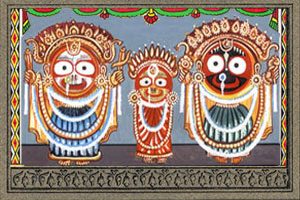
Suna Vesha “gold”. The Suna Vesha consists of many solid gold ornaments. The 11th day of the bright fortnight in the month of Ashada is known in Orissa as Bahudha Ekadasi, when the Deities return from the Gundicha Mandir on their chariots; they appear in the Suna (Gold) Vesha when the Lordships have arrived in Their cars near the Lion Gate of Jagannatha Temple. They are decorated with golden ornaments and wear gold crowns. Lord Jagannath and Lord Balabhada appear with hands and feet made of gold. Lord Jagannath holds a golden chakra in His right hand and a silver conch shell in His left. Lord Balabhadra holds a golden club in His right hand and a golden plough in His left. It is said that the total weight of the solid gold ornaments of the Suna Vesha worn by Lord Jagannatha, Baladeva and Subhadra is more than one ton.
Month of Sravana (July – August)
Chita Lagi Vesha: In Orissa the new moon day in the month of Sravana is known as Chita Lagi Amavasya. Lord Jagannatha for most of the year wears a golden flower ornament on his forehead known as Chita. On the Snana Purnima day this ornament is removed. On the Chita Lagi Amavasya it is again put on the forehead of Lord Jagannatha.
Rahurekha Lagi Vesha: On Snana Yatra day, in the karnapatra or golden earring of Lord Jagannatha are removed. On the fifth day of the bright moon of the month of Sravana, they are again put on the Deities. This is known as the Rahurekha Lagi Vesha.
Month of Bhadrapada (August – September)
During the month of Bhadrapada, Jagannatha is offered several special dresses. After Janmastami, from the Dasami to the Dvadasi, three different dresses, all relating to Krishna’s pastimes in Vraja, are worn by Lord Jagannatha, Vanabhojana Vesha, Kaliya Damana Vesha and Pralamba Vadha Vesha. The King of Puri takes charge of all these dresses.
Vanabhoji Vesha:
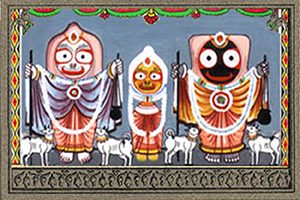 The Vanabhoji Vesha is offered to the Deities on the tenth day of the dark fortnight of the month of Bhadrapada. Their Lordships are dressed like cowherd boys going on a picnic in the forest with their friends. Many Gopis, Gopas, Cows, Birds and Peacocks made of Sola are placed on the altar to create the mood of Vrindavana. Vana means forest, and Bhoji means to take one’s meal.
The Vanabhoji Vesha is offered to the Deities on the tenth day of the dark fortnight of the month of Bhadrapada. Their Lordships are dressed like cowherd boys going on a picnic in the forest with their friends. Many Gopis, Gopas, Cows, Birds and Peacocks made of Sola are placed on the altar to create the mood of Vrindavana. Vana means forest, and Bhoji means to take one’s meal.
Kaliya Damana Vesha:
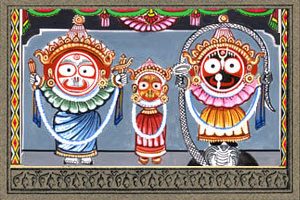 This Besha is being celebrated to commemorate how Krishna controlled the proud Kaliya, the multi hooded snake residing in Kalandi lake at the bank of river Yamuna and forced him to quit the lake along with his family. A huge snake is built (30 feet) long for the Besha purpose. The hood of the snake placed at the feet of Sri Jagannath at the time Besha. Everything is made of Sola. This Besha is continued till completion of Sandhya Dhupa. (Evening dhupa).
This Besha is being celebrated to commemorate how Krishna controlled the proud Kaliya, the multi hooded snake residing in Kalandi lake at the bank of river Yamuna and forced him to quit the lake along with his family. A huge snake is built (30 feet) long for the Besha purpose. The hood of the snake placed at the feet of Sri Jagannath at the time Besha. Everything is made of Sola. This Besha is continued till completion of Sandhya Dhupa. (Evening dhupa).
Pralambasura Vesha:
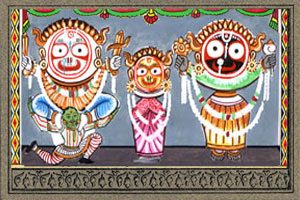 On the 12th day dark fortnight of the month of the month of Bhadrapa Jagannatha is offered the Vesha known as Pralambasura or Pralambavadha. In the Krishna lila (Dwapar yuga) to celebrate the killing of a demon named Pralambasura by Lord Balarama, Lord Balaram(Baladeva) wears this decoration known as the Pralambavadha vesha. This Besha is made on Baladeva only while Jagannath & Subhadra remain in general form.
On the 12th day dark fortnight of the month of the month of Bhadrapa Jagannatha is offered the Vesha known as Pralambasura or Pralambavadha. In the Krishna lila (Dwapar yuga) to celebrate the killing of a demon named Pralambasura by Lord Balarama, Lord Balaram(Baladeva) wears this decoration known as the Pralambavadha vesha. This Besha is made on Baladeva only while Jagannath & Subhadra remain in general form.
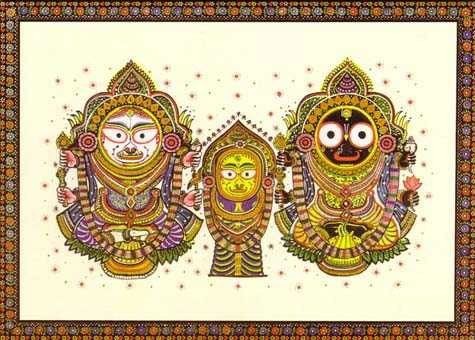

 Every year on the auspicious day of Ashadh Sud 2, in early July, the Rath Yatra festival celebrated by Hindus. Rath means chariot, Yatra – a pilgrimage or procession. Though this festival is celebrated all over India and world, it originated in Jagannath Puri on the eastern coast of India. Every year the deities of Jagannath Mandir – Lord Jagannath, Balaram and Subhadra – are traditionally installed on huge chariots. Devotees pull the chariots in a yatra (procession) through the street called Bada Danda. The local king used to serve humbly sweeping the road ahead with a golden broom.
Every year on the auspicious day of Ashadh Sud 2, in early July, the Rath Yatra festival celebrated by Hindus. Rath means chariot, Yatra – a pilgrimage or procession. Though this festival is celebrated all over India and world, it originated in Jagannath Puri on the eastern coast of India. Every year the deities of Jagannath Mandir – Lord Jagannath, Balaram and Subhadra – are traditionally installed on huge chariots. Devotees pull the chariots in a yatra (procession) through the street called Bada Danda. The local king used to serve humbly sweeping the road ahead with a golden broom.

